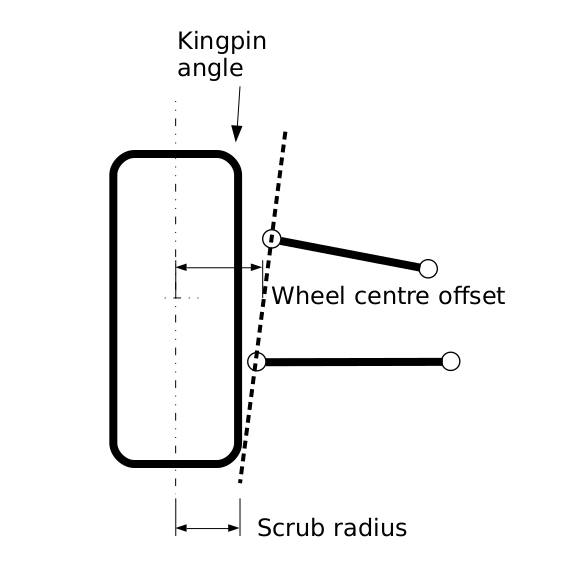Kingpin angle is a measure of the angle of the suspension steer axis relative to vertical in front view. The steer axis (or kingpin axis) on a conventional double wishbone suspension passes through the upper control arm and lower control arm ball joints. On a MacPherson strut, the kingpin axis is defined by a line passing through the strut top bearing and the lower ball joint. Kingpin angle is measured in Degrees and is positive when the top of the steering axis points towards the centre of the car. Scrub radius is the distance from the steer axis to the centre of the tyre contact patch at ground level and wheel centre offset is the distance from the kingpin axis to the wheel centre. All three are shown in the figure below.

With any kingpin angle, steering will tend to raise and lower the vehicle. Therefore to steer away from the straight ahead position, work must be done by the driver, This contributes to steering wheel returnability as this work is recovered when the steering wheel is released. Returnability is the tendency of the steering wheel to self centre when a vehicle is driving and is important for vehicle stability. Returnability increases with increased kingpin angle. The fact that steering raises and lowers the vehicle also means that increased kingpin inclination contributes to increased steering efforts, although it is not a major contributor to the overall steering efforts.
Kingpin angle (like castor angle) contributes to wheel camber change with steering input. With a positive kingpin angle, the outside wheel in a corner will gain positive camber and the inside wheel will loose positive camber. As the outside wheel is the heavily loaded wheel during cornering, this increase in positive camber acts against bump camber and will reduce the cornering capacity of the outside tyre.
In general kingpin angles between 6-14 Deg are seen on production vehicles. MacPherson strut suspensions would be towards the upper end of this range with values closer to the lower end achieved on double wishbone suspensions.
The scrub radius is the lever arm for braking forces into the suspension. A positive scrub radius (i.e. the kingpin axis intersects the ground inboard of the wheel centre line) will give a toe out tendency on a front axle when subject to a braking force. In a brake in bend scenario, this gives an understeer tendency which is desirable from a stability point of view. On the other hand, a negative scrub radius (kingpin axis intersect the ground outboard of the wheel centre line) has stability benefits for split mu braking. In the extreme scenario, with only one wheel braking, the car will tend to steer towards the braking wheel. The toe-in which results from the negative scrub radius on the braking wheel will counteract this and improve stability. In most production vehicles, scrub radius is kept to small values (either positive or negative). A scrub radius less than 10-15 mm would be ideal but is not always achievable.
The wheel centre offset is the lever arm for traction or impact forces into the suspension. Excessive wheel centre offset on front wheel drive cars or four-wheel drive cars manifests itself as torque steer. It also contributes to steering kickback or white lining. This is the steering wheel torque feedback a driver feels when driving over obstacles or along painted lines on a road surface. For these reasons it should be minimised. Low wheel centre offset is particularly important for high performance front wheel drive vehicles to prevent torque steer. Good examples of more advanced suspension systems designed to minimise wheel centre offset are the ‘Revo’ knuckle on the Mk2 Ford Focus RS and ‘Super Strut’ front suspension on the ST205 Toyota Celica GT-Four. In production vehicles, wheel centre offsets of ~50-75mm can be achieved with MacPherson strut type suspensions, double wishbone systems can be designed to have values closer to 40mm. The ‘Revo’ knuckle type systems mentioned above can achieve between 20-30mm.
There are suspension packaging constraints which ultimately determine the kingpin axis, wheel centre offset and scrub radius in any suspension design. The ideal scenario is to minimise all three to give the best overall vehicle performance. However, with conventional suspension systems, very low values of kinpin inclination, wheel centre offset and scrub radius result in conflicting requirements and a compromise must be reached. To minimise scrub radius, the lower control arm ball joint is typically positioned as far outboard as possible whilst still allowing for brake disk package. Once the lower ball joint is positioned, the upper ball joint is positioned to achieve the desired balance between scrub radius, wheel centre offset and kingpin angle.
—
